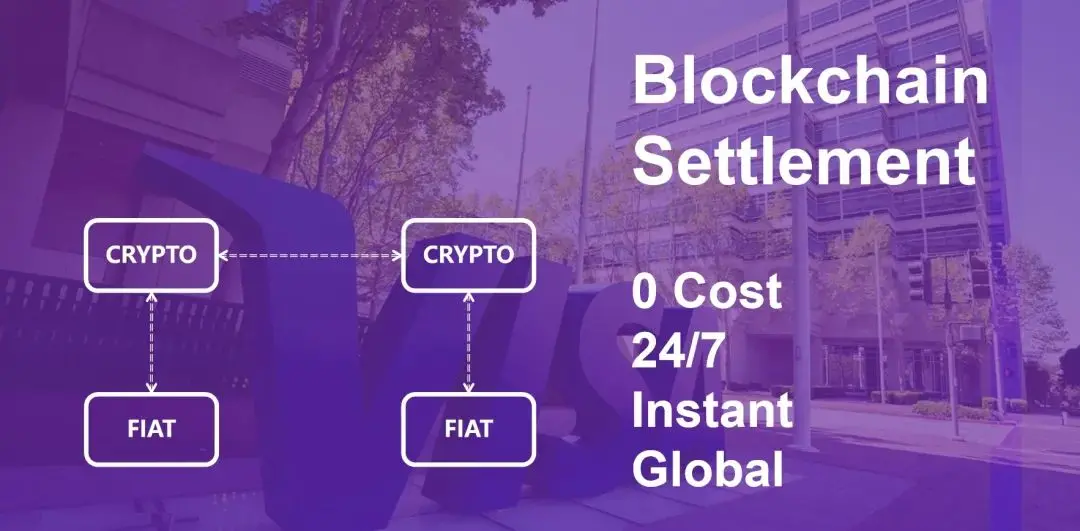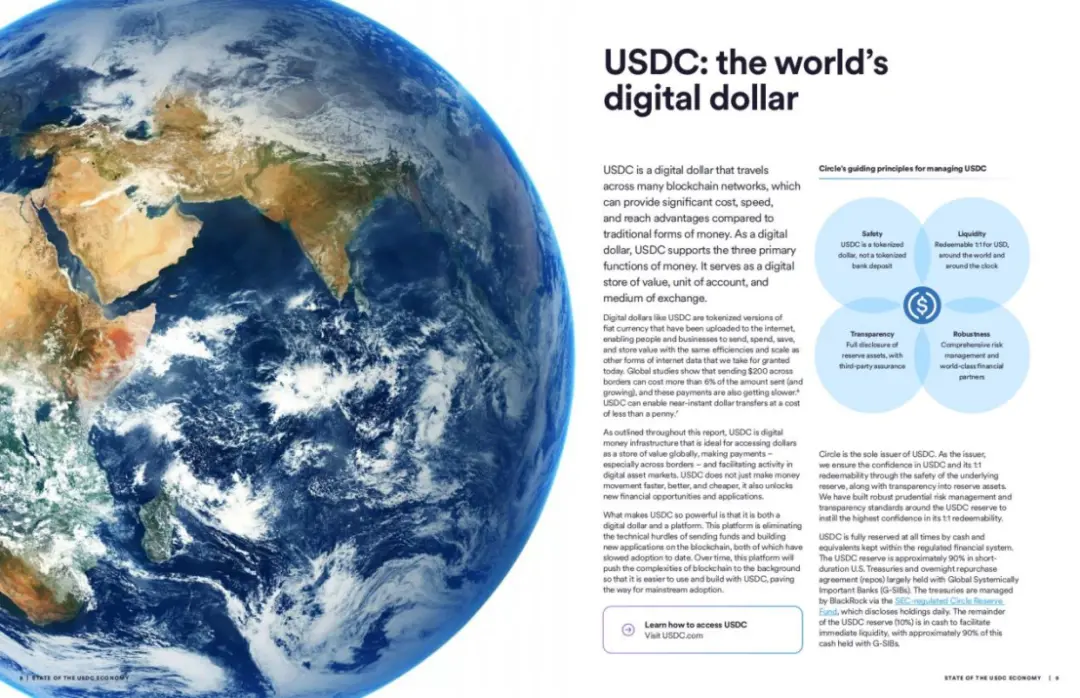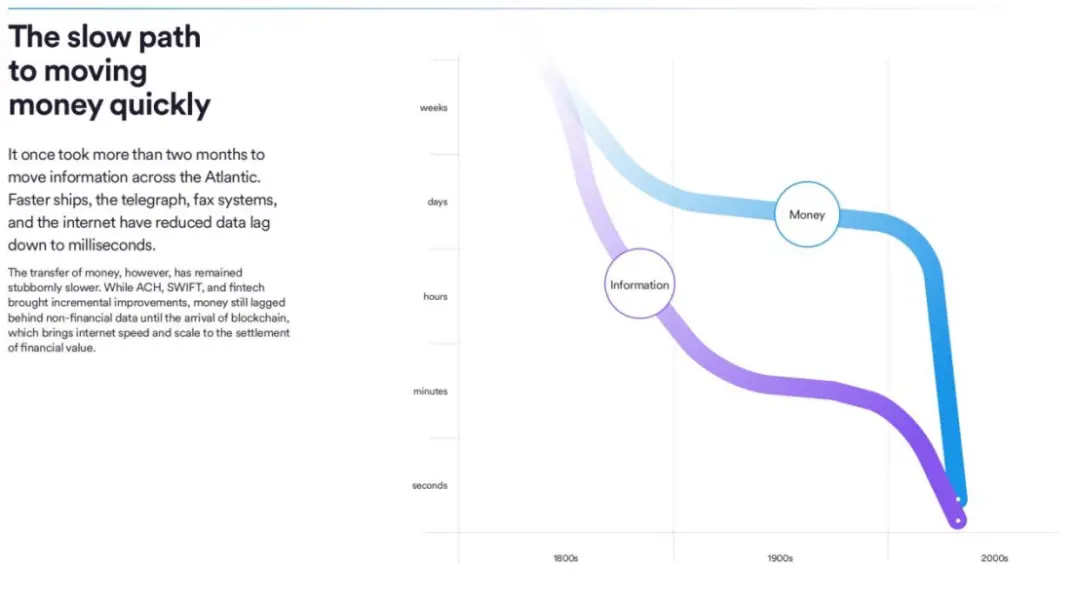Author: Will Awang, Web3 Little Law
In early 2025, Circle published the article "Digital Dollar on the Value Internet - 2025 USDC Market Economic Report", which clearly outlined the three narratives of USDC: (1) Financial upgrade of the internet; (2) Interconnected network through USDC; (3) Expanding USDC application scenarios using network effects.
For Circle, which currently holds a 26% market share in stablecoins, it is evident that the first two narratives are no longer sufficient. Therefore, the recently launched Circle Payments Network represents its role as a globally compliant stablecoin issuer, capturing the value of USDC or stablecoins within the global network.
The US dollar and the internet inherently possess strong network effects. In both the real world and online, the US dollar is a currency with network effects. Blockchain technology endows USDC with more powerful functions and new application potential compared to traditional dollars, while relying on traditional internet networks for implementation.
Circle is building an open technology platform centered around USDC, leveraging the strength and widespread use of the dollar today to fully utilize the scale, speed, and cost advantages of the internet, achieving similar network effects and practicality for financial services.
The Circle Payments Network is a framework where Circle, utilizing its strong compliance background, brings together financial institutions (USDC services) within a compliant, seamless, and programmable structure to coordinate global payments in fiat currency, USDC, and other payment stablecoins.
As a result, fiat currency no longer needs to circulate through the outdated traditional SWIFT system; digital dollars using blockchain as a settlement layer will be its new pathway.
Essentially, Circle's payment network based on blockchain as a settlement layer serves as an invitation to the funeral of traditional payment channels like SWIFT/VISA/Mastercard, ushering us into a monumental era of transformation from mailing letters to emails, from horse-drawn carriages to electric vehicles, and from transatlantic cable telegraphs to blockchain internet value transfer.
Importantly, Circle's positioning of the Circle Payments Network: a brand new protocol layer built on a comprehensive, open, and internet-based settlement system, with stablecoins at its core. This positioning allows compatibility with various public chain settlement layers, rather than getting caught up in the battle for financial infrastructure among public chains.
Dr. Xiao Feng from Hashkey, starting from the essence of finance, provides a positioning for public chains: a new generation of financial infrastructure that not only marginally improves existing systems but also brings disruptive developments in transactions, clearing, and settlement, forming a new financial paradigm.
Significantly, Circle aims to create an open network based on blockchain, which already has the prototype of the VISA network. We may find some answers in the subsequent evolution of VISA's development history. This stands in stark contrast to the relatively closed networks formed by Ripple & RippleNet and Stripe & Bridge.
In October 2023, while sharing Web3 Payments with Ant Group, I was contemplating whether bringing fiat assets on-chain and settling through stablecoins is a better solution. Clearly, a year and a half later, Circle has provided a clear answer and distinct use cases.
Thus, this article compiles Circle's Circle Payments Network Whitepaper to explore its design principles, real-world use cases, future potential use cases and growth opportunities, as well as the governance model similar to that of the VISA network.
1. Whitepaper Overview
Stablecoins have long been considered to have the potential to become the foundation for payments and capital flow on the internet. However, until recently, stablecoins, as Digital Cash, have primarily been used in the global digital asset market and decentralized finance (DeFi) sector.
With the launch of the Circle Payments Network (CPN), Circle is advancing stablecoins to a new level, enabling them to upgrade the global payment system—much like how previous internet innovations transformed media, commerce, software, communication, and other industries. These significant changes greatly improved customer experience, reduced costs, increased speed, and drove economic growth for individuals and businesses worldwide.
To realize this potential, the Circle Payments Network (CPN) aims to overcome many of the barriers that have so far limited the adoption of stablecoins in mainstream payments. These barriers include entry thresholds, ambiguous compliance requirements, technical complexities, and concerns about the secure storage of digital cash.
The Circle Payments Network (CPN) brings together financial institutions within a compliant, seamless, and programmable framework to coordinate global payments in fiat currency, USDC, and other payment stablecoins.
These financial institutions' corporate and individual clients can enjoy payment services that are faster and cheaper than traditional payment systems, which are often constrained by fragmented networks or closed systems. Crucially, the Circle Payments Network (CPN) lays the foundation for this entire ecosystem, eliminating many of the technical complexities and operational barriers that have hindered mainstream stablecoin adoption to date, including the need for enterprises to self-custody stablecoins. The Circle Payments Network (CPN) also opens the door for breakthroughs in programmable currency, unlocking new uses for currency in global value exchange.
This whitepaper outlines the design principles of the Circle Payments Network (CPN), summarizes initial and recent use cases, and presents future potential use cases and growth opportunities. The aim is to help financial institutions, payment companies, application developers, innovators, and other stakeholders understand their roles in building and utilizing the Circle Payments Network (CPN)—and how the network enables them to innovate and deliver the advantages of stablecoins to their customers.
2. Introduction
2.1 Deficiencies in the Global Financial Payment System
The current global economy is more interconnected than ever, yet unlike other economic sectors, the infrastructure supporting capital flow still primarily relies on frameworks established before the internet era.
In the past, it was impossible to provide a "money protocol" that could transfer value in a fully native digital form over the internet.
The Automated Clearing House (ACH) in the U.S. and other similar protocols have become core components of the fragmented global payment landscape, which emerged globally in the early 1970s. Although there have been some recent developments, such as the Single Euro Payments Area (SEPA) in the Eurozone, Brazil's PIX, and India's Unified Payments Interface (UPI) real-time payment systems, which have improved the speed of domestic transactions, they still lack a globally interoperable standard and scale, and have not leveraged the openness and scalability of building programmable currency on open blockchain networks.
Businesses and individuals worldwide are paying a high price for relying on this traditional payment infrastructure. According to a McKinsey report (Global Payments in 2024), the global payments industry generates over $2.4 trillion annually. Much of this "revenue" is generated from fees charged to senders and receivers, reflecting the operational complexity and intermediation of traditional infrastructure—essentially a tax on global commerce and households.
Currently, the reality is that international wire transfer fees can reach up to $50 per transaction, and intermediaries along this path often charge additional fees. According to the World Bank, the global average cost of sending $200 in the second quarter of 2024 was 6.65%. Furthermore, foreign exchange conversions exacerbate these challenges, introducing costly forex fees and price volatility.
The fragmented settlement processes in the agency banking system continue to impose significant economic costs on businesses and society. For importers and purchasers, payments can take days to clear, which may weaken their cash flow and increase the complexity of liquidity planning. For exporters and sellers, unpredictable multi-day settlement windows mean they must rely more on expensive short-term working capital loans to maintain short-term operations. Recipients who depend on cross-border remittances for food, housing, and other basic living needs may face the risk of significant income erosion due to the intervention of traditional intermediaries, while also enduring payment delays. In some cases, they may also face the inherent risks of handling cash in environments prone to crime.
(Digital Dollar on the Value Internet - 2025 USDC Market Economic Report)
2.2 Change Has Arrived
Change has long been overdue. While the internet has nearly transformed every aspect of global business over the past few decades, the way funds flow still relies on a fragmented traditional network that lacks transparency, efficiency, and innovation. Although some countries have successfully implemented national real-time payment systems, these solutions cannot scale globally and have limited access for developers.
Since the emergence of early payment information and settlement systems like ACH half a century ago, global communication technology has evolved to connect people around the world instantly. Today, billions can watch movies on their phones while riding the subway, access all of humanity's knowledge at almost zero cost, and buy and sell nearly all products from around the globe.
It is time to adopt a new way of global fund flow—one that operates around the clock, connects seamlessly, and aims to eliminate the inefficiencies of traditional payment systems while relying on and integrating the solid foundation of the traditional financial system.
(Digital Dollar on the Value Internet - 2025 USDC Market Economic Report)
2.3 Internet-Based Currency Settlement Layer - Circle Payments Network
With the launch of the Circle Payments Network (CPN), this vision is becoming a reality. The Circle Payments Network (CPN) is a brand new protocol layer built on a comprehensive, open, and internet-based settlement system, with USDC, EURC, and future regulated payment stablecoins at its core. By connecting an open platform with global scale and reducing intermediaries, CPN enables fund flow in ways that traditional closed networks cannot achieve.
Importantly, CPN does not directly transfer funds; rather, it serves as a marketplace for financial institutions and acts as a coordinating protocol to facilitate seamless global fund flows and information exchange.
CPN marks the first time that regulated settlement assets (in the form of stablecoins) are combined with a coordination and governance layer designed specifically for financial institutions. This integration connects traditional payment systems with assets like USDC and EURC while establishing a trusted counterparty framework for more efficient, less intermediary-dependent global settlement.
By introducing a new "Clearing Layer" based on compliant, round-the-clock digital dollars, CPN lays the foundation for internet-scale cross-border settlement.
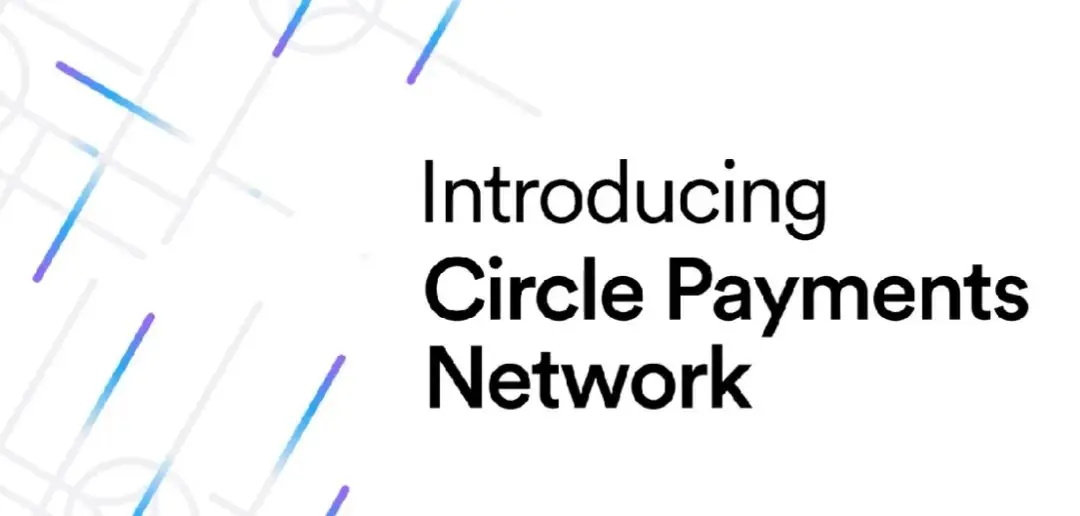
(https://x.com/circle/status/1914411337683480654)
2.4 Benefits of Circle Payments Network
A. Internet Financial Payment Services
CPN will benefit billions of people and tens of millions of businesses, enabling them to access funds and other financial services just like other transformative global internet services. Payers can choose to initiate payments using fiat or stablecoins, while recipients (whether businesses or individuals) can choose to retain stablecoins upon receipt or convert them to local currency. CPN will make near-instant, borderless payments a universal reality.
The launch of CPN makes it easier to envision a future where international suppliers can receive cross-border payments almost instantly and at low cost through a modern, compliance-first platform that supports global supply chains; small merchants can achieve near-real-time collections without high fees eroding sales profits; global sellers can directly enter new markets; content creators can receive small payments from consumers with the cost efficiency of stablecoins; and remittance recipients can receive a larger proportion of remittance amounts, thereby enhancing purchasing power where it is most needed.
B. Reducing Technical Complexity
In addition to serving as an upgrade to many of today's inter-institutional payment networks (which are often burdened by traditional infrastructure, closed ecosystems, and slow or expensive settlements), CPN is designed as a modern Payment Orchestration Layer based on stablecoins and blockchain, enabling scalable expansion.
While blockchain-based payments have gained some traction, they are not frictionless or fully trusted in inter-institutional environments, where features such as settlement guarantees, reversibility, compliance, standardized protocols, and robust security are fundamental requirements. CPN further reduces technical complexity and minimizes the operational and financial challenges that have so far hindered stablecoins from entering mainstream payments and commerce, paving the way for a more efficient, inclusive, innovative, and transparent financial ecosystem.
C. Cost Reduction and Efficiency Improvement
From a cost and efficiency perspective, CPN is a powerful alternative to traditional cross-border payments. Although purchasing stablecoins and converting them back to fiat incurs some fees, in many markets outside the U.S., the costs of these "in-and-out currency exchanges" are decreasing and may be lower than obtaining dollars through banks.
Traditional dollar transfers can be both expensive and slow for senders and receivers, making both parties more reliant on short-term working capital financing (as mentioned earlier). By enabling near-instant settlements and reducing reliance on intermediaries, CPN can unlock significant cost efficiencies.
Additionally, as an open platform, CPN has the potential to foster a competitive market for currency exchanges, foreign exchange, and other services, further lowering costs and improving access conditions.
D. Transparency, Security, and Scalability
CPN is a transparent, secure, and scalable infrastructure designed to help financial institutions better serve their corporate and individual clients. Crucially, CPN will be able to unlock these efficiencies without sacrificing compliance. Circle has established a rigorous governance framework for CPN, requiring participating financial institutions to comply with global anti-money laundering and counter-terrorism financing (AML/CFT) standards and economic sanctions requirements.
E. Open Infrastructure Promotes Innovation
Importantly, CPN does not directly transfer funds; rather, it serves as a marketplace for financial institutions and acts as a coordinating protocol to facilitate seamless global fund flows and information exchange. As the network operator, Circle defines the CPN protocol and provides application programming interfaces (APIs), developer software development kits (SDKs), and public smart contracts to coordinate global fund flows.
The growth and success of CPN will not only be limited to the Circle ecosystem but will also rely on participants outside Circle to jointly unlock economic value. This network will provide fertile ground for banks, payment companies, currency exchange service providers, application developers, and other regulated stablecoin issuers to innovate together, delivering greater value and better experiences for their own customers.
It is precisely based on this open public blockchain infrastructure that CPN and regulated payment stablecoins provide builders with a powerful foundation to launch on-chain applications that seamlessly transfer funds using these networks.
CPN offers innovators and builders the building blocks to develop new user experiences and support a wide range of payment use cases. Over time, builders will be able to create a vibrant ecosystem of modules and application services on top of CPN—building a third-party functionality marketplace for CPN participants and end-users, benefiting them and unlocking a new and powerful distribution platform for fintech developers.
3. Circle's Vision
Through the Circle Payments Network (CPN), Circle is building a new platform and network ecosystem that will create value for every stakeholder in the global economy, helping to accelerate the benefits this internet-based new financial system brings to society:
Businesses:
Importers, exporters, merchants, and large enterprises: can leverage financial institutions supporting CPN to eliminate significant costs and friction, strengthen global supply chains, optimize cash management operations, and reduce reliance on expensive short-term working capital financing.
Individuals:
Remittance senders and receivers, content creators, and other individuals who frequently send or receive small payments: will gain greater value, as financial institutions using CPN will be able to provide these improved services faster, at lower costs, and more simply.
Ecosystem Builders:
Banks, payment companies, and other providers: can leverage the CPN platform services to develop innovative payment use cases, utilizing the programmability of stablecoins, SDKs (Software Development Kits), and smart contracts to create a thriving ecosystem. Over time, this will fully unlock the potential of stablecoin payments for businesses and individuals. Additionally, third-party developers and enterprises can introduce value-added services to further expand the network's capabilities.
All participants in the CPN network and end-users will benefit from an open and continuously upgradeable fund flow infrastructure, which not only reduces the cost of cross-border payments and increases speed but also ensures the technological readiness of the internet financial system.
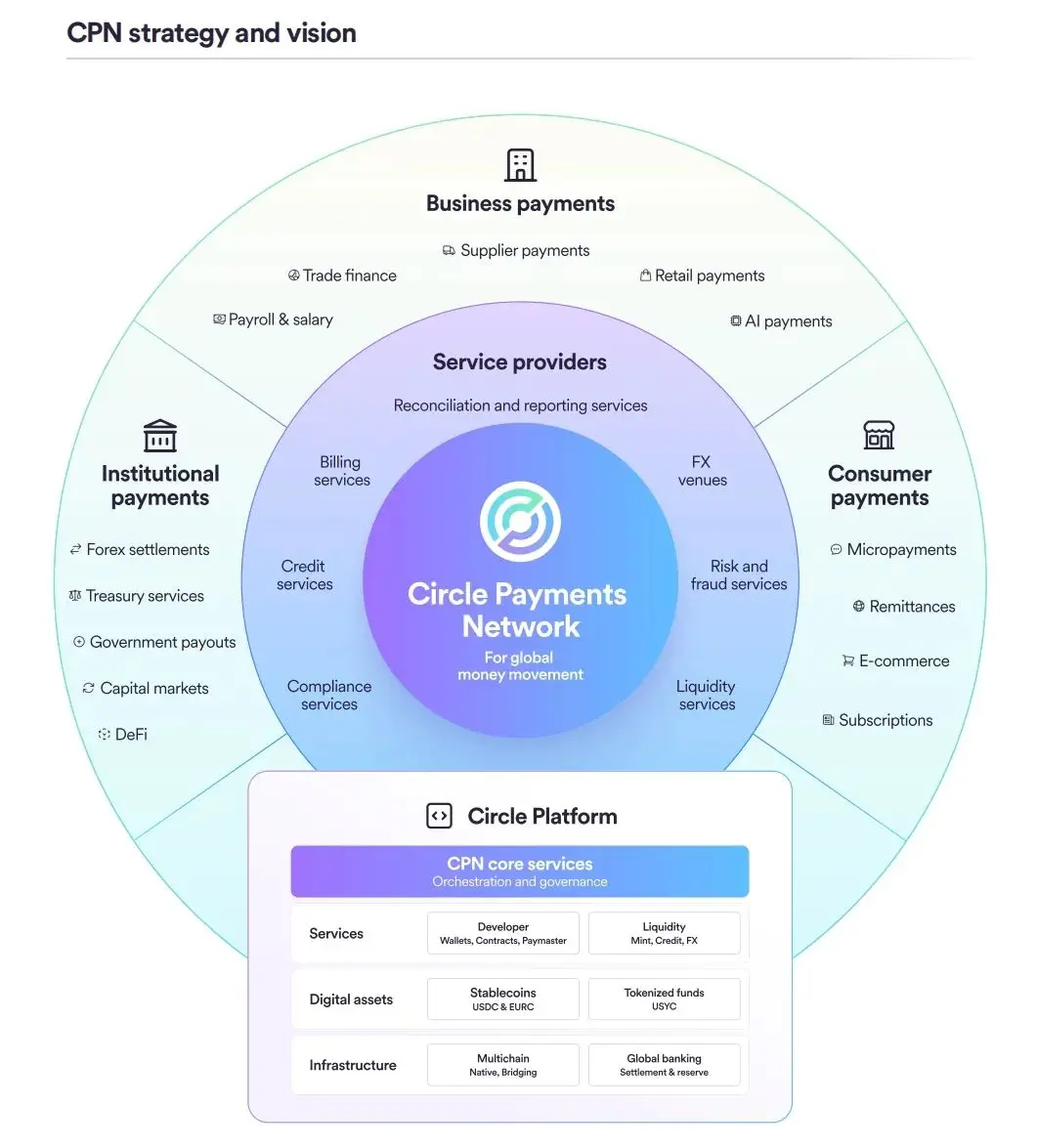
(www.circle.com/cpn)
4. Use Cases
The Circle Payments Network (CPN) aims to support a wide range of payment and value transfer use cases by enabling seamless, efficient, and secure transactions using regulated stablecoins on supported blockchain networks.
Its compliance-oriented architecture allows Originating Financial Institutions (OFI) to discover and connect to Beneficiary Financial Institutions (BFI) through CPN, while empowering ecosystem builders to develop innovative solutions for individuals, businesses, and institutions.
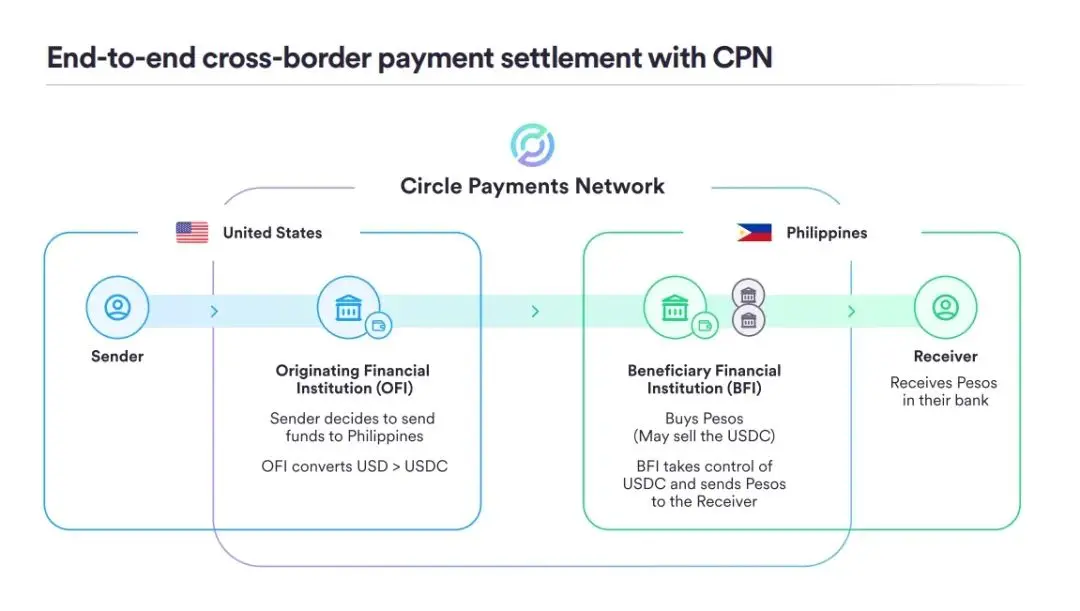
(www.circle.com/cpn)
4.1 Business Payments
A. Supplier Payments
Accelerate and simplify cross-border payments between companies by shortening settlement times and eliminating intermediaries.
A manufacturing company in Mexico needs to make a payment to a steel supplier in Germany but wants to avoid high foreign exchange fees and multi-day bank transfers. The company's OFI converts Mexican pesos (MXN) to USDC, connects with the BFI in Germany through CPN, and sends USDC. The BFI then seamlessly converts USDC to euros and settles the funds instantly into the supplier's account.
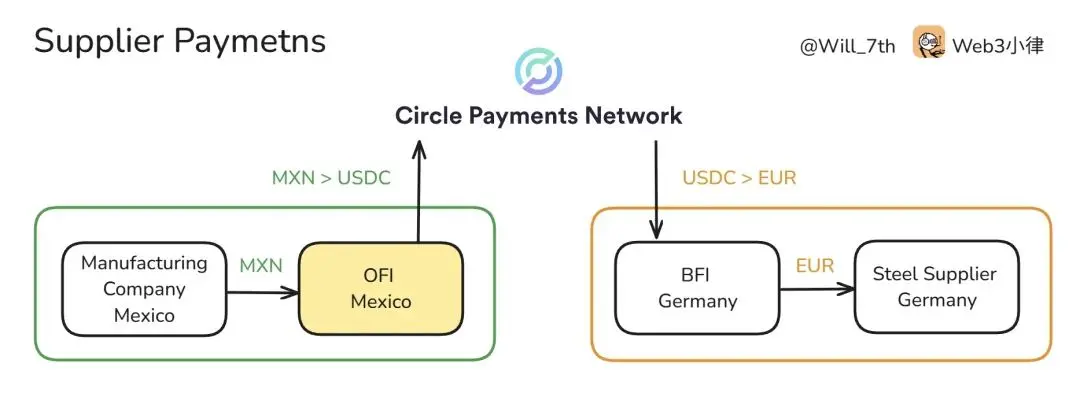
B. Retail Payments
Enhance global online commerce with secure, efficient, and flexible payment options.
A fashion retailer in Brazil sells products to customers in the United States. The retailer's BFI connects with an OFI through CPN to receive dollar payments. The OFI converts dollars to USDC and sends it to the BFI, which then seamlessly converts USDC to Brazilian reais (BRL) or holds it as USDC with a digital asset custodian on behalf of the retailer, allowing the retailer to receive funds instantly, faster than traditional payment processors, and choose to retain working capital as digital dollars.

C. Trade Finance
Simplify and secure international trade payments.
An American textile importer places an order with an Indian manufacturer and wants to reduce the time and cost of traditional trade financing. The importer's OFI converts dollars (USD) to USDC and connects with a BFI in India through CPN to transfer funds. The BFI manages the custody of USDC through smart contracts and settles Indian rupees (INR) to the manufacturer after verifying shipping documents. This method achieves faster settlements, reduces counterparty risk, and provides custody services using the innovation of smart contracts.

D. Payroll and Salary Disbursements
Enable businesses to handle global payroll payments with minimal fees and instant settlements.
A multinational company pays salaries to remote employees in multiple countries. The company does not rely on traditional banking channels but instead converts local currency to USDC through its OFI and immediately disburses salaries to employees via multiple BFIs discovered through CPN. These BFIs receive USDC from the OFI and complete the final payment in each employee's local currency.
E. AI Payments
In the future, CPN will support autonomous AI agents to send and receive payments on behalf of users or systems, facilitating real-time value exchange.
A logistics company uses AI agents to book freight services across borders. When the agent selects a service provider in Singapore, it uses an OFI integrated with CPN to convert dollars (USD) to USDC and automatically sends the payment to the BFI in Singapore, which then converts it to Singapore dollars (SGD). The entire payment process is programmatically executed through smart contracts, minimizing manual steps and enabling intelligent cross-border machine-to-machine payments.
4.2 Consumer Payments
A. Remittances
Empower individuals with fast and cost-effective remittance services, avoiding high fees and delays.
A user living in the United States wants to send money to family in the Philippines. As a remittance company acting as the OFI in the U.S., it converts dollars (USD) to USDC and simultaneously converts USDC to Philippine pesos (PHP) through a dynamically discovered local BFI in the Philippines via CPN, delivering funds to their family in near real-time, with fees only a fraction of traditional remittance costs.
B. Subscriptions
Support regular payments for digital services through programmable stablecoin billing.
A digital media platform offers premium subscription services to users worldwide. Each month, users' digital wallets initiate a USDC payment through the OFI, which is routed through the BFI discovered via CPN. The BFI receives the funds, holding them as USDC with a digital asset custodian on behalf of the media platform or converting them to local fiat as needed and crediting the media platform's account.
C. Micropayments and Content Monetization
Provide instant, low-cost micropayment support for content creators and digital services.
A content creator in Brazil receives small donations from global fans through CPN, using a local OFI and a CPN-supporting BFI. Fans can send stablecoins instantly—avoiding long delays and high platform fees—enabling quick and low-cost monetization.
D. E-commerce
Expand consumer access to global online markets through fast payment experiences.
A customer in the UK purchases electronics from a seller in South Korea via an international e-commerce platform. At checkout, the customer pays in pounds (GBP) through a local OFI, which converts the funds to USDC and transfers them to the BFI in South Korea. The BFI converts USDC to Korean won (KRW) and deposits it into the seller's account.
4.3 Institutional Payments
A. Capital Markets Settlement
Enhance trading efficiency by achieving faster, more transparent settlements between financial institutions, reducing counterparty risk and operational costs.
An American asset management company executes an OTC bond trade with a European investment bank but wants to avoid T+2 settlement delays, which lead to capital inefficiencies and counterparty risk. The asset management company's OFI converts dollars (USD) to USDC and connects with the BFI in Europe through CPN to transfer USDC, which the BFI then settles instantly in euros (EUR) for the investment bank.
B. Foreign Exchange (FX)
Simplify currency exchange by improving the efficiency of multi-currency operations and addressing the high foreign exchange rates and complexities and delays of traditional providers.
A European investment company wants to fund a real estate acquisition in Japan but wishes to avoid high foreign exchange fees and delays. The investment company's OFI converts euros (EUR) to EURC, and the BFI in Japan seamlessly exchanges it for yen (JPY) at competitive on-chain FX venues and settles instantly.
C. Treasury Services
Simplify fund repatriation by efficiently converting overseas income back to the company's domestic market.
A U.S.-based enterprise software provider offers cloud-based solutions to numerous businesses in Southeast Asia. To repatriate income from the region to the U.S., the company's BFI in the U.S. discovers a local OFI in the Philippines through CPN. The OFI collects payments in Philippine pesos (PHP) from corporate clients, converts them to USDC, and transmits them to the BFI in the U.S. The BFI then converts USDC to dollars (USD) and deposits them into the company's treasury management account, enabling faster and compliant global income consolidation.
D. Government and Humanitarian Payments
Provide secure, reliable, and efficient channels for large-scale payments, from disaster relief funds to institutional transfers.
An international non-governmental organization (NGO) uses stablecoins to distribute disaster relief funds. The NGO initiates payments through its Originating Financial Institution (OFI), which converts local currency into USDC and transfers it to the Beneficiary Financial Institution (BFI) operating in the affected area. The BFI then either delivers the funds directly to the beneficiary's digital wallet or converts USDC into local currency and deposits it into their bank account, ensuring transparency, accelerating fund delivery, and enhancing accountability in aid distribution.
E. Decentralized Finance Integrations (DeFi Integrations)
Support DeFi innovators by providing a foundation for lending, borrowing, saving, etc., unlocking the potential of mainstream on-chain finance.
A properly licensed and regulated DeFi lending platform integrates USDC and EURC to offer loan and savings products. With the infrastructure of CPN, the platform can facilitate seamless cross-border transactions, reduce volatility, and support compliant institutional client liquidity while building trust among a diverse user base.

5. CPN Ecosystem Stakeholders and Roles
The CPN ecosystem consists of ecosystem stakeholders and participants who play a vital role in facilitating global payments, driving technological innovation, and promoting network governance, economic value creation, and network adoption.
5.1 CPN Governance Body
Circle serves as the primary governance and standard-setting body for CPN, as well as the network operator.
Circle's main responsibilities include:
Establishing and maintaining the "Circle Payments Network Rules" ("CPN Rules"), which govern the eligibility, operations, and compliance of all participants.
Developing and maintaining core infrastructure—smart contracts, APIs, and SDKs—to enable seamless payment settlements (sending/receiving transactions) across blockchain networks.
Operating coordination protocols for member and price discovery, payment routing, and settlement between counterparties.
Facilitating standardized and automated information sharing among members to ensure compliance with the Travel Rule.
Verifying the eligibility of financial institutions, approving their participation in the network, and issuing certificates confirming compliance with CPN standards related to licensing, anti-money laundering and counter-terrorism financing (AML/CFT), sanctions compliance, and financial strength.
Monitoring members' compliance with regulatory requirements (including AML/CFT and sanctions) through ongoing risk-based reviews.
Planning and managing network security, incident response, and infrastructure to ensure operational integrity and resilience.
Introducing pre-reviewed third-party service providers and modular applications that meet CPN compliance, security, and performance standards.
5.2 CPN Members
Members, also known as Participating Financial Institutions (PFIs), are the backbone of CPN. They act as counterparties, initiating, facilitating, or receiving payments within the network and executing transactions according to CPN rules and governance standards.
PFIs include virtual asset service providers (VASPs), traditional and crypto-native payment service providers (PSPs), and financial institutions such as traditional or digital banks. Depending on their role in transactions, PFIs may act as Originating Financial Institutions (OFIs) initiating payments on behalf of senders or as Beneficiary Financial Institutions (BFIs) receiving stablecoin payments and facilitating last-mile fiat payments through local payment systems, or providing stablecoin custody services on behalf of recipients.
Core responsibilities of CPN members include:
Maintaining appropriate licenses and ensuring ongoing compliance with applicable regulations in all relevant jurisdictions, including AML/CFT and sanctions requirements, while adhering to CPN rules.
Participating in Circle's qualification process and keeping legal entity information, compliance status, jurisdictional scope, and risk profile up to date.
Conducting risk-based assessments of counterparties and transactions using information collected through CPN and executed oversight based on their compliance obligations.
Executing payments through a range of technical services and protocols detailed in CPN rules based on their role as OFI or BFI.
Complying with CPN's technical and infrastructure requirements, including secure integration, service level agreement (SLA) performance, transaction monitoring, and data protection agreements.
Sharing necessary sender and beneficiary information in accordance with CPN's Travel Rule compliance framework, requests for information (RFIs), and other oversight requests.
Monitoring transactions to detect and report suspicious activities in accordance with applicable regulations.
Participating in CPN governance through structured feedback, operational reviews, and member reputation scoring to enhance transparency and support continuous improvement.
Providing timely support and solutions to other members or end-users regarding network inquiries.
Utilizing CPN's developer SDK, regulated stablecoins, and smart contract infrastructure to develop and offer innovative payment use cases.
5.3 CPN End Users (Businesses and Individuals)
End users are the ultimate initiators and beneficiaries of payment transactions—although they do not interact directly with CPN, they benefit from lower costs, faster settlements, higher transparency, and ongoing innovation. Senders initiate payments through Originating Financial Institutions (OFIs), while beneficiaries receive payments through Beneficiary Financial Institutions (BFIs).
5.4 CPN Service Providers
These entities include financial institutions (FIs) and non-financial institutions (non-FIs) that provide value-added technological solutions and financial services to CPN members and end users.
They include:
Liquidity Providers and FX Venues: These entities provide efficient market-making, price discovery, and currency exchange services for stablecoin transactions within CPN. They offer liquidity for cross-border stablecoin settlements and ensure competitive foreign exchange rates.
Stablecoin Issuers: These institutions issue regulated payment stablecoins, which serve as the primary medium of exchange within CPN. Stablecoin issuers ensure transparent reserves, regulatory compliance, and underlying fiat liquidity that supports seamless cross-border transactions.
Technology Solutions and Financial Service Providers: These service providers offer a range of services to CPN members, including fraud and risk management, wallet infrastructure, custody solutions, billing and invoicing, as well as compliance and transaction monitoring solutions to support their business and operational needs.

(www.circle.com/cpn)
6. CPN Governance, Qualification, and Network Operations
CPN operates under a collaborative and transparent governance framework designed to prioritize compliance, security, and trust within the network. This framework encompasses three key aspects of governance:
Qualification and Oversight: Circle, as the primary governance body, is responsible for establishing stringent qualification standards, which are detailed in the "Circle Payments Network Rules," and promoting the integration of regulated payment stablecoins into the network.
Network Functionality and Operations: Core functionalities support seamless and compliant transactions while ensuring operational rigor and continuous improvement.
Transparency and Stakeholder Engagement: By actively engaging with a diverse range of stakeholders (including financial institutions, regulators, businesses, and builders), CPN aligns with global standards to enhance trust, accelerate adoption, and promote sustainable network ecosystem growth.
Network operations:
Limited to legally authorized financial institutions;
Mandatory anti-money laundering and counter-terrorism financing (AML/CFT) and sanctions compliance;
Secure transaction data sharing, including the Travel Rule;
Ongoing audits and oversight.
6.1 Qualification and Oversight
The governance framework of CPN defines qualification standards, certification protocols, and the integration of regulated stablecoins to ensure the trustworthy participation of financial institutions, regulated stablecoin issuers, and service providers in the network.
A. Stringent Qualification Standards
Members must meet comprehensive qualification requirements before gaining access to the network. This includes holding all necessary licenses, implementing sanctions and anti-money laundering (AML) programs consistent with local regulations and global standards, maintaining reasonable security controls, and demonstrating sufficient financial strength. As the network operator, Circle assesses all potential members before granting access and conducts regular reassessments based on risk. Members licensed under robust regulatory regimes established by international compliance standard-setting bodies (such as the Financial Action Task Force (FATF)) will undergo standard reviews, while others will require more in-depth assessments. Qualification standards are published, and Circle's assessments can also serve as input for members' own counterparty due diligence processes.
B. Member Certification and Access
Upon successful completion of qualification verification and approval, CPN issues unique network certifications to qualified members. These certifications enable counterparties to securely identify each other and retrieve counterparty information, facilitating transparency, informed risk assessments, and improving the efficiency of counterparty due diligence. The certification includes a set of clearly defined attributes—including membership status, jurisdictional scope, and qualification information—that are continuously monitored and updated to reflect changes in the risk landscape.
C. Integration of Regulated Payment Stablecoins
The governance framework of CPN outlines a structured assessment and approval process for integrating new regulated payment stablecoins into CPN. Potential stablecoins must undergo rigorous evaluation based on CPN's strict qualification standards, including regulatory compliance, transparent reserves and audit proof, availability of banking payment channels, underlying fiat liquidity, risk management standards, information and network security capabilities, and reporting practices. Only stablecoins that fully meet these standards and receive approval from the governance body can operate within the network, ensuring they contribute to a stable, secure, and efficient network ecosystem.
6.2 Network Functionality and Operations
CPN enables members to conduct secure, real-time transactions through a robust operational framework that ensures consistency, scalability, and resilience. This framework includes transaction coordination, operational support, incident response, and infrastructure management.
A. Transaction Coordination and Risk Management
Transactions within CPN are coordinated through a series of technical services and protocols, ensuring seamless execution among participating members. Additionally, network members continuously monitor transaction flows using automated alerts provided by CPN and regular risk assessments, focusing on transaction anomalies and partner performance, such as evaluating failed transaction rates and service level agreement (SLA) violations. These measures collectively mitigate operational risks proactively, helping to maintain the reliability and efficiency of the network.
B. Member Operational Support
CPN provides clear operational guidelines, including service level agreements (SLAs) defined in the CPN rules, covering expectations for uptime, transaction speed, dispute resolution, and timely information sharing. The network also standardizes the exchange of transaction and counterparty data, simplifying operations by reducing the need for customized coordination.
C. Incident and Crisis Management
CPN has established detailed protocols for managing security incidents, regulatory compliance issues, and system outages. These protocols include predefined communication channels with members and a transparent and fair resolution process, ensuring swift action and effective management of disputes, whether related to compliance or transaction issues.
D. Infrastructure Scalability and Planning
CPN's infrastructure is continuously monitored through observability tools that track throughput, latency, and error rates. Automated performance monitoring and regular load testing enable the network to scale according to demand. Circle collaborates with vetted infrastructure and cloud partners to ensure the allocation of resilient computing and storage resources. Scalability reviews and corridor-level stress tests validate the network's readiness for increased transaction volumes and network expansion.
6.3 Transparency and Stakeholder Engagement
The governance of CPN is built on transparency, which helps establish trust and confidence among all participants. As the governance body, Circle takes strategic recommendations to strengthen the governance framework based on advice from the advisory committee. CPN regularly conducts surveys, focus groups, and structured reviews to gather feedback from members and assess service quality. This input drives continuous improvement and helps ensure that the network's development meets the needs of participants. Independent audits and regular public reporting of transaction volumes, system uptime, and member compliance further reinforce operational integrity and accountability.
Representatives of CPN members and end users, along with interactions with regulatory bodies, play a crucial role in the network's development. CPN members are encouraged to actively participate in the formulation of network rules and technical standards by providing suggestions and operational insights that help shape the network's strategy and growth. Additionally, Circle's financial services division maintains ongoing interactions with global regulators, leveraging its strong track record to ensure that CPN aligns with international standards—particularly those related to anti-money laundering and counter-terrorism financing (AML/CFT) and the Financial Action Task Force (FATF) Travel Rule standards—operating in a secure, trustworthy, and compliant environment.
7. CPN Core Services
CPN serves as a coordination protocol designed specifically for stablecoins, enabling seamless, compliant, and programmable global transactions.
CPN utilizes public blockchain networks for final settlement while optimizing payment coordination, compliance-related data exchange, and smart routing between payment stablecoins and network members. Stablecoins are the foundational digital asset class within CPN, providing the stability, interoperability, and programmability required for high-trust financial applications.
At launch, the network supports USDC and EURC, with plans to expand to other regulated payment stablecoins that meet CPN's strict governance and qualification standards. Over time, CPN will become the foundation for builders to develop interoperable modules and application services that will extend the network's utility and unlock new use cases for global payments and financial innovation.
7.1 Payment through Smart Coordination
CPN's payment protocol is built on a hybrid architecture that combines off-chain and on-chain systems, helping to aggregate liquidity and facilitate price discovery among network members. As more payment stablecoins join the network, CPN will evolve into an on-chain foreign exchange routing infrastructure, enabling efficient and instant exchanges between stablecoins while still coordinating transaction settlements between Originating Financial Institutions (OFIs) and Beneficiary Financial Institutions (BFIs).
In the initial version of CPN, coordination occurs through an off-chain API system that generates transaction requests. OFIs sign these requests to initiate the transfer of USDC or EURC to the designated BFI wallet. At this stage, Circle (as the network operator and governance body) broadcasts the transaction to the appropriate blockchain. This process verifies payment details, ensuring the correct amounts and tokens are delivered to the BFI, and that all associated fees are covered within the agreed settlement timeframe.
Subsequently, CPN will transition to a smart contract protocol architecture, enhancing the network's composability and introducing more efficient, value-added features. The CPN smart contract payment protocol is designed to facilitate seamless on-chain payments between members using stablecoins (including USDC and EURC). By leveraging smart contracts, the protocol will enable transactions with minimized error risk, automated reconciliation, and efficient fee collection while maintaining a non-custodial design.
Under this protocol, OFIs initiate payments by deploying smart contracts on the public blockchain network supported by CPN. The contract verifies key transaction parameters (such as token type, amount, recipient address, and deadline) before executing the payment. Unlike traditional transfers that are prone to errors and require separate invoicing for transaction fees, smart contracts enforce precise payments and efficiently route transactions to different BFIs in cases involving multiple bids and offers.
To enhance transparency and security, each transaction is uniquely identified and timestamped, ensuring clear auditability for compliance and reconciliation purposes. Additionally, the protocol will include an optional "revocation" feature in the future, allowing senders to cancel erroneous transactions within a brief window before final confirmation.

(www.circle.com/cpn)
7.2 Optimizing FX through Smart Discovery and Routing
CPN enables participating Originating Financial Institutions (OFIs) to discover Beneficiary Financial Institutions (BFIs) and send stablecoins for payment settlement. During the discovery process, CPN allows OFIs to query the network for specific stablecoin or fiat currency pairs. This system enables OFIs to discover network participants and request corresponding exchange rates and liquidity. Initially, the platform will integrate USDC and EURC with local fiat liquidity order books and private liquidity sources. Over time, the system will transition to a fully on-chain foreign exchange (FX) routing, aggregation, and settlement architecture—providing direct access to on-chain FX pools, order books, and private liquidity. The network's discovery capabilities will include order routing, while a Request-for-Quote (RFQ) system will further optimize FX execution to meet the performance standards of traditional payment systems.
While the network initially focuses on discovering liquidity among BFIs, it will gradually expand to include on-chain venues on a whitelist—such as automated market makers (AMMs), on-chain order books, and other liquidity providers—to broaden access to stablecoin liquidity. Once discovered, CPN will intelligently match orders from these sources, enabling direct stablecoin foreign exchange conversions, with built-in security measures and transparent execution coordinated by Circle as the network operator.
7.3 Seamless Cross-Chain Settlement Payments
CPN supports native settlement of stablecoins across multiple blockchains, providing a seamless cross-chain payment transfer mechanism. Participating Financial Institutions (PFIs) bring their preferred blockchains into the network, while CPN coordinates transactions between the selected source blockchain and target blockchain for efficient payment settlement. With Circle's Cross-Chain Transfer Protocol (CCTP version 2), CPN offers fast and secure cross-chain transfers for permitted stablecoins, ensuring transactions maintain speed and integrity within the blockchain network. Initially, the platform will support a limited number of blockchains at launch, with plans to expand to more blockchains based on the preferences of network members.
7.4 Protecting Confidentiality through Selective Transparency
CPN will introduce advanced confidentiality-enhancing features on public blockchains to protect transaction data, helping members fulfill privacy and operational obligations. These mechanisms allow users to designate certain transactions as confidential, ensuring sensitive payment information does not permanently appear on the public blockchain. This capability supports a wide range of applications, enabling businesses to maintain confidentiality for critical activities (such as corporate payments, trade financing, and payroll) through CPN.
Additionally, CPN will adopt a confidentiality protocol (which will be defined separately and not included in this white paper) to enable selective disclosure. Under this protocol, transaction details will only be visible to authorized parties (including counterparties, law enforcement, regulators, and auditors) when required for compliance or legal purposes.
7.5 Expanding Capabilities through Composability and Trusted Interoperability
To expand the value of the network ecosystem, CPN allows pre-reviewed third-party protocols to integrate and interoperate with its core infrastructure, enhancing the practicality and versatility of its payment capabilities. Circle envisions a range of diverse integrations—including lending and credit, liquidity aggregation, institutional yield, custody, subscription services, and more. Participation is limited to protocols that have been whitelisted, audited, and rigorously reviewed by Circle, which must meet strict regulatory compliance, security, and liquidity management standards. Through this composable architecture, CPN aims to unlock a secure, programmable foundation and third-party ecosystem for global payments, financial services, and technology-driven solutions.
8. CPN Economic Model
The economic model and incentive mechanisms of CPN are designed to drive early rapid adoption while establishing a sustainable long-term revenue strategy for all network members. It aligns incentives among all network members, end users, builders, and service providers to promote network growth and sustainability.
Transactions processed through CPN will incur three main types of fees:
Payout Fees: Compensate Beneficiary Financial Institutions (BFIs) for local fiat payments and processing costs.
FX Spreads: Reflect liquidity risks and currency exchange costs.
CPN Network Fees: A tiered variable basis point charge based on country grouping to support the core functions of the network, including compliance, security, infrastructure, and development.
As CPN grows and Circle and third-party developers introduce new value-added services through selected markets, additional usage-based fees will be implemented to support and maintain these services. These services may include fraud detection tools, risk management, wallet infrastructure, custody, billing, and advanced compliance capabilities. First-party (1P) and third-party (3P) service fees will create revenue opportunities for providers and enable financial institutions to customize payment experiences through modular, plug-and-play solutions.
A portion of the network and market fees will be strategically reinvested into core priorities such as infrastructure upgrades, research and development, network operations, user acquisition incentives, and developer ecosystem growth—including funding support for CPN integrations and new applications. This reinvestment approach aims to enhance the platform's resilience, drive innovation, and accelerate long-term network expansion.
免责声明:本文章仅代表作者个人观点,不代表本平台的立场和观点。本文章仅供信息分享,不构成对任何人的任何投资建议。用户与作者之间的任何争议,与本平台无关。如网页中刊载的文章或图片涉及侵权,请提供相关的权利证明和身份证明发送邮件到support@aicoin.com,本平台相关工作人员将会进行核查。
